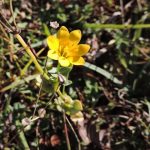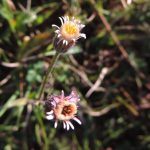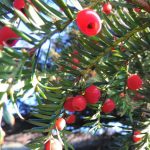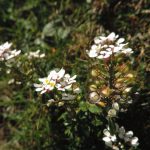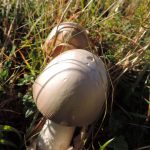Michael Keith-Lucas led a well-attended walk at the National Trust’s Watlington Hill on the warm and sunny afternoon of Sunday 21 October. There were a few fungi in the wood next to the car park, including the poisonous Yellow Stainer. The track led out into open chalk grassland, with distant, slightly hazy, views across a large section of Oxfordshire. Many plants were still in flower, including Rough and Autumn Hawkbit, Wild Basil, Carline Thistle, Harebell, Yellow-wort, Blue Fleabane, Dwarf Thistle and Dewberry. A line of small, off-white fungi with an incense-like smell in the short turf were identified later as Cedarwood Waxcaps. Michael pointed out the different plants on the sides of the ant hills, with Common Rock-rose and Wild Thyme on the south side and Wild Strawberry on the north side. There were cushions of Common Rock-rose, with a few plants still in flower. The walk continued into an area of Yew woodland. At the base of some of the trees were branches from long-dead Juniper bushes which had the distinctive smell of freshly-sharpened pencils. Michael explained that the hillside would originally have been tightly grazed by sheep, but the Juniper bushes would have given protection from browsing animals to young Yew seedlings. These eventually grew into spreading trees which deprived the Junipers of light and killed them. Below the Yew wood was another open area of grassland. A Peacock butterfly was seen here, together with the flowers of Wild Candytuft, Small Scabious, Clustered Bellflower and Eyebright. Glossy black berries of Wild Privet were noted beside the path. Also seen here was the last surviving Juniper bush on Watlington Hill. It had a good crop of berries, but there were no signs of rejuvenation. The route led back into dark Yew woodland. In a more open clearing were plants of Deadly and Woody Nightshade. Emerging from the dark woodland, the path led up onto a section of hillside where there were abundant berries on Buckthorn and Dogwood. A small group of Grisettes, greyish fungi growing out of bag-like volvas and with finely grooved cap margins, were found here. A Red Admiral butterfly was disturbed and Pale Toadflax and Lady’s Bedstraw were added to the flower count. Patches of acid sand had the holes of solitary bees, flowering Gorse bushes and Bracken.
Pictures by Rob Stallard
Plants seen:
| English name | Scientific name |
| Traveller’s-joy | Clematis vitalba |
| Rough Hawkbit | Leontodon hispidus |
| Perforate St John’s-wort | Hypericum perforatum |
| Salad Burnet | Poterium sanguisorba |
| Wild Marjoram | Origanum vulgare |
| Agrimony | Agrimonia eupatoria |
| Selfheal | Prunella vulgaris |
| Gorse | Ulex europaeus |
| Male-fern | Dryopteris filix-mas |
| Yellow-wort | Blackstonia perfoliata |
| Carline Thistle | Carlina vulgaris |
| Blue Fleabane | Erigeron acer |
| Common Centaury | Centaurium erythraea |
| Germander Speedwell | Veronica chamaedrys |
| Dogwood | Cornus sanguinea |
| Dewberry | Rubus caesius |
| Harebell | Campanula rotundifolia |
| Wild Mignonette | Reseda lutea |
| Fairy Flax | Linum catharticum |
| Yew | Taxus baccata |
| Dwarf Thistle | Cirsium acaule |
| Wild Privet | Ligustrum vulgare |
| Small Scabious | Scabiosa columbaria |
| Blackthorn | Prunus spinosa |
| Eyebright | Euphrasia nemorosa |
| Wild Candytuft | Iberis amara |
| Clustered Bellflower | Campanula glomerata |
| Juniperus communis | Juniper |
| Dog’s Mercury | Mercurialis perennis |
| Deadly Nightshade | Atropa belladonna |
| Heath Speedwell | Veronica officinalis |
| Buckthorn | Rhamnus catharticus |
| Rosebay Willowherb | Chamerion angustifolium |
| Lady’s Bedstraw | Galium verum |
| Pale Toadflax | Linaria repens |
List by Renée Grayer

